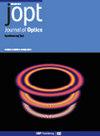Pressure-dependent bandgap characteristics in photonic crystals with sensing applications
IF 2.7
4区 物理与天体物理
Q3 OPTICS
引用次数: 0
Abstract
The present study elucidates a photonic crystal (PhC)-based pressure sensor exploiting the change in refractive index with pressure and the corresponding structural deformation of the dielectric material. The stress-sensitive refractive indices of the constituent materials of the PhC have been considered to study the effect of applied pressure on the photonic bandgap (PBG) characteristics of the structure. The designed pressure sensor, proposed using a two-dimensional hexagonal lattice arrangement of air holes in a dielectric slab, operates in the high-pressure range of 1–6 GPa. A comparative study of the PBG characteristics with the application of high pressure has been reported for three semiconducting materials—GaAs, Ge and Si, used for the dielectric slab in the proposed structure. GaAs is found to exhibit the highest sensitivity to pressure variations and shows more pronounced shifting of the midgap wavelength with pressure in comparison to Ge and Si. The largest PBG is seen in the Ge-based structure, closely followed by the GaAs and Si-based structures. The proposed structure is suitable for high-pressure sensing applications.光子晶体中与压力相关的带隙特性与传感应用
本研究阐明了一种基于光子晶体(PhC)的压力传感器,它利用了折射率随压力的变化以及介电材料相应的结构变形。研究考虑了光子晶体组成材料的应力敏感折射率,以研究施加压力对结构的光子带隙(PBG)特性的影响。所设计的压力传感器是利用电介质板中气孔的二维六边形晶格排列设计的,可在 1-6 GPa 的高压范围内工作。报告对拟议结构中用于电介质板的三种半导体材料--砷化镓、锗和硅进行了高压应用下 PBG 特性的比较研究。研究发现,与 Ge 和 Si 相比,GaAs 对压力变化的敏感度最高,中隙波长随压力的变化也更为明显。基于 Ge 的结构具有最大的 PBG,紧随其后的是基于 GaAs 和 Si 的结构。所提出的结构适用于高压传感应用。
本文章由计算机程序翻译,如有差异,请以英文原文为准。
求助全文
约1分钟内获得全文
求助全文
来源期刊

Journal of Optics
OPTICS-
CiteScore
4.50
自引率
4.80%
发文量
237
审稿时长
1.9 months
期刊介绍:
Journal of Optics publishes new experimental and theoretical research across all areas of pure and applied optics, both modern and classical. Research areas are categorised as:
Nanophotonics and plasmonics
Metamaterials and structured photonic materials
Quantum photonics
Biophotonics
Light-matter interactions
Nonlinear and ultrafast optics
Propagation, diffraction and scattering
Optical communication
Integrated optics
Photovoltaics and energy harvesting
We discourage incremental advances, purely numerical simulations without any validation, or research without a strong optics advance, e.g. computer algorithms applied to optical and imaging processes, equipment designs or material fabrication.
 求助内容:
求助内容: 应助结果提醒方式:
应助结果提醒方式:


